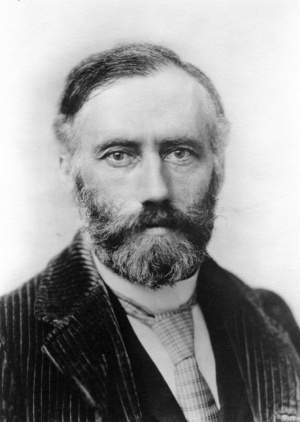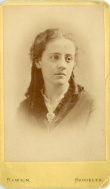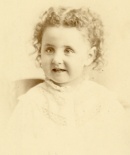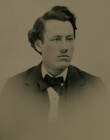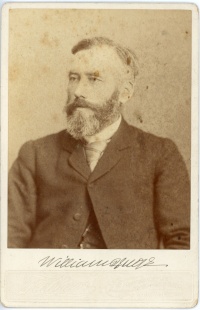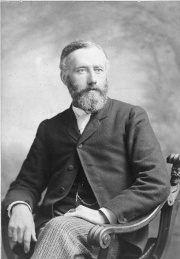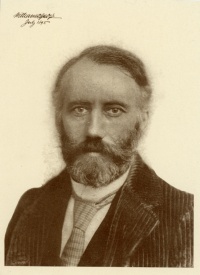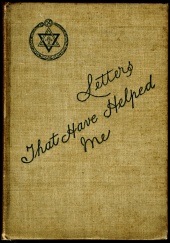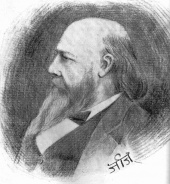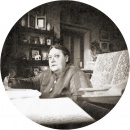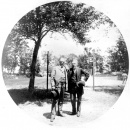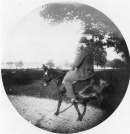William Quan Judge: Difference between revisions
No edit summary |
|||
| (67 intermediate revisions by 2 users not shown) | |||
| Line 1: | Line 1: | ||
[[File:WQ Judge.jpg|300px|right|thumb|William Quan Judge]] | |||
'''[[William Quan Judge]]''' ([[April 13]], 1851 – [[March 21]],1896) was one of the principal [[Founders]] of the [[Theosophical Society]] in 1875. He provided superb leadership to the American Section until his untimely death in 1896, but left a body of writings that are among the clearest explications of the principles of [[Theosophy]]. | |||
See also '''[[Judge writings]]'''. | |||
[[File:WQ Judge.jpg| | |||
'''[[William Quan Judge]]''' was one of the principal [[Founders]] of the [[Theosophical Society]] in 1875. He provided superb leadership to the American Section until his untimely death in 1896, but left a body of writings that are among the clearest explications of the principles of [[Theosophy]]. See '''[[Judge writings]]'''. | == Personal life == | ||
[[File:Judge wife - Rawson CDV .jpg|right|110px|thumb|Ella Judge]] | |||
William Quan Judge was born in Dublin, Ireland on [[April 13]], 1851 to Frederick "Fred" Hughes Judge (1822-1880) and Alice Mary Quan. | |||
Fred Judge became a Freemason in 1856.<ref>Ireland, Grand Lodge of Freemasons of Ireland Membership Registers, 1733-1923.</ref> In 1847 he married Alice. They had seven children, of whom William was the third. There were four girls – Lucinda ("Lucy"), Alice, Emily, and Carrie – and three boys – William, [[John Henry Judge|John]], and Frederick. When only seven years old, William was struck by serious illness and was near death. | |||
[[File:Judge daughter Alice.jpg|right|130px|thumb|Alice Judge]] | |||
<blockquote> | <blockquote> | ||
During the year of his convalescence, he began to show an interest in mystical subjects. Unaware of his ability to read, the family found him engrossed in books dealing with Mesmerism, Phrenology, Magic, Religion and similar subjects.<ref>Boris de Zirkoff, "Judge, William Quan" ''H. P. Blavatsky Collected Writings'' Volume I (Wheaton, Illinois: Theosophical Press, 1966), 472.</ref> | |||
</blockquote> | </blockquote> | ||
Mrs. Judge died in 1858 at the birth of the youngest son. On July 14, 1864, the Judge family emigrated to the United States, sailing on the Inman Liner ''City of Limerick.'' Fred Judge initially worked in Brooklyn as a clerk, and later was a merchant of building supplies. Six of the children were with him; Carrie was absent from the household - probably dead before she turned twelve.<ref>"Frederic Hughes Judge" in the New York, New York, Index to Death Certificates, 1862-1948.</ref><ref>New York, State Census, 1865.</ref> The 1870 census shows Fred remarried to Jennie Minerva Burch, with the six children. William was then studying law.<ref>1870 United States Federal Census.</ref> | |||
[ | William married '''Ella Miller Smith''', a school teacher, on September 16, 1874. They residence was initially in Brooklyn, New York with Ella's father, Joseph Smith, owner of a shoe store. Their daughter Alice was born on June 13, 1875, but died very young of diphtheria. Joseph Smith seems to have retired, and his son-in-law took over as head of the household, which also included Ella's older sister Joanna.<ref>New York, State Census, 1865.</ref><ref>1880 United States Federal Census.</ref> Ella, like her husband, was a Methodist, but her beliefs took a stricter form than his, and she never accepted his interest in Theosophy. She did, however, eventually became member of the Society for a brief time, joining on March 29, 1994.<ref>Theosophical Society General Membership Register, 1875-1942 at [http://tsmembers.org/ http://tsmembers.org/]. See book 1, entry 10964 (website file: 1D/38).</ref> Judge's sister Emily joined that same week.<ref>Theosophical Society General Membership Register, 1875-1942 at [http://tsmembers.org/ http://tsmembers.org/]. See book 1, entry 10921(website file: 1D/37).</ref> They may have been trying to express support for William when he was ill and under siege. | ||
== Legal and business career == | |||
== Legal career == | |||
After his schooling was completed, young Judge sought work in the legal profession. | After his schooling was completed, young Judge sought work in the legal profession. | ||
<blockquote> | <blockquote> | ||
He | He became a naturalized American citizen in April, 1872, and was admitted to the State Bar of New York one month later. His industry, natural shrewdness and inflexible persistence commended him to his clients and he became, as time went on, a specialist in Commercial Law.<ref>Boris de Zirkoff, "Judge, William Quan" ''H. P. Blavatsky Collected Writings'' Volume I (Wheaton, Illinois: Theosophical Press, 1966), 472.</ref> | ||
</blockquote> | </blockquote> | ||
[[File:Judge tintype.jpg|110px|left|thumb|Young WQJ]] | |||
By the autumn of 1874, when he first met [[H. P. Blavatsky]], he was employed in the law office of E. Delafield Smith, U S. Attorney for the Southern District of New York. He represented Madame Blavatsky in her divorce from [[Michael C. Betanelly]], and the divorce was granted on [[May 25]], 1878. | |||
From 1879 to 1881, Judge traveled to Venezuela and Mexico on business ventures that were ultimately unsuccessful; he was laden with debt and a damaged law practice. He was exposed to the insect-borne tropical parasite that causes '''Chagas Disease''' (sometimes misidentified as the short-lived Chagres Fever). No treatment was available, and he suffered its effects greatly for the rest of his life. | |||
In 1884, after returning to New York after his visit to the [[Theosophical Society|Theosophical Society's]] international headquarters at [[Adyar (campus)|Adyar, Madras, India]], "Judge found his financial prospects greatly improved. He joined the law firm | In 1884, after returning to New York after his visit to the [[Theosophical Society|Theosophical Society's]] international headquarters at [[Adyar (campus)|Adyar, Madras, India]], "Judge found his financial prospects greatly improved. He joined the law firm in which Olcott's brother worked."<ref>Boris de Zirkoff, 473.</ref> | ||
<br> | |||
<br> | |||
== Meeting Olcott and Blavatsky == | == Meeting Olcott and Blavatsky == | ||
| Line 35: | Line 39: | ||
After reading Col. Olcott's articles in the New York ''Daily Graphic'' (published in March, 1875, as a work entitled ''People from the Other World'') outlinging his experiences as the Eddy homestead at Chittenden, Vt., where some weird [[Spiritualism|Spiritualistic]] ''séances'' were being held, he wrote to the Colonel asking for an introduction to Madame Blavatsky. Eventually the desired invitation came, and resulted in an association that was to last throughout their lives. | After reading Col. Olcott's articles in the New York ''Daily Graphic'' (published in March, 1875, as a work entitled ''People from the Other World'') outlinging his experiences as the Eddy homestead at Chittenden, Vt., where some weird [[Spiritualism|Spiritualistic]] ''séances'' were being held, he wrote to the Colonel asking for an introduction to Madame Blavatsky. Eventually the desired invitation came, and resulted in an association that was to last throughout their lives. | ||
Judge became a frequent visitor at H.P.B.'s apartment, at 46 Irving Place, New York, where the founding of the Theosophical Society was soon to take place.<ref>Boris de Zirkoff, 473. | Judge became a frequent visitor at H.P.B.'s apartment, at 46 Irving Place, New York, where the founding of the Theosophical Society was soon to take place.<ref>Boris de Zirkoff, 473.</ref> | ||
</blockquote> | |||
His younger brother [[John | His younger brother [[John Henry Judge]] was also involved with H.P.B., assisting her in preparing the manuscript of | ||
[[Isis Unveiled (book)|''Isis Unveiled'']] for publication. William Quan Judge's wife Ella, however, was actively opposed to his engagement in Theosophical interests. | [[Isis Unveiled (book)|''Isis Unveiled'']] for publication. William Quan Judge's wife Ella, however, was actively opposed to his engagement in Theosophical interests. | ||
== Communication with Mahatmas == | |||
The first written communication to Judge from the Masters was described in a letter to [[Damodar|Dâmodar]] dated June 11, 1883. Judge wrote: "I have your last. On the back is written in red pencil 'Better come [[Morya|M.]]'" A few months later, Judge journeyed to Europe and then India.<ref>The original of WQJ's letter in reply to Damodar's letter, on the back of which M sends his message, is in the Archives of the Theosophical Society, Adyar; Damodar's letter is missing.</ref> | |||
Two letters have been published (in text and replica) that were written from [[Morya|Master Morya]] to Mr. Judge. See '''[[Mahatma Letter to Judge No. 1|Letter 1]]''' and '''[[Mahatma Letter to Judge No. 2|Letter 2]]'''. | |||
As with the [[Mahatma Letter to Besant - LMW 1 No. 59|"1900 Letter"]] of [[Annie Besant]], doubt has sometimes been cast upon the authenticity of letters received after the death of [[H. P. Blavatsky]] in 1891.<ref>Constance Wachtmeister, "H.P.B. And The Present Crisis In The Theosophical Society" ''Theosophy in Australasia'' (July 5, 1895), 5-8. For a more extended quotation see [https://theosophists.org/library/books/h-p-b-and-the-present-crisis-in-the-theosophical-society-1895/ Theosophists.org website].</ref> That doubt was a significant factor in the crisis that enveloped the Society in 1894-1895. | |||
[[Claude Bragdon]] wrote: | |||
<blockquote> | |||
There is abundant evidence, aside from the best evidence of all -- the fruitfulness of his labors -- that he was under the direct guidance of the Masters. One Adept wrote of him, "when the presence is upon him, he knows well that which others only suspect and 'divine'." In the same letter he is referred to as the one "who of all chelas suffers most and demands, or even expects, the least."<ref>Claude Bragdon, ''Episodes from an Unwritten History'', pp. 24-5</ref> | |||
</blockquote> | |||
[[File:Judge Taber cabinet card .jpg|200px|right|thumb|Signed cabinet card by Taber, San Francisco]] | |||
== Theosophical work == | == Theosophical work == | ||
=== Founding of the Theosophical Society === | === Founding of the Theosophical Society === | ||
=== Early years | During a meeting at Madame Blavatsky's rooms on Tuesday, September 7, 1875, a stimulating lecture was given by [[George H. Felt]], who claimed to be able to summon [[Elementals|elemental spirits]]. Colonel Olcott, H. P. Blavatsky, W. Q. Judge, and others agreed that it would be desirable to form a Society to study such phenomena. After several more meetings, by-laws were adopted and officer elected. [[Henry Steel Olcott|Colonel Olcott]] was chosen as President; [[G. H. Felt]] and Dr. [[Seth Pancoast]] as Vice-Presidents; [[Helena Petrovna Blavatsky|Madame Blavatsky]], Corresponding Secretary; [[John Storer Cobb]] Recording Secretary; [[Henry J. Newton]], Treasurer; [[Charles Sotheran]], Librarian; and William Q. Judge was chosen as Counsel to the Society. Its [[Founding of the Theosophical Society|founding]] became public with an inaugural address by Colonel Olcott on [[October 30]], 1875.<ref>Henry Steel Olcott, ''Old Diary Leaves'' First Series (Adyar, Madras: The Theosophical Publishing House, 1974), 135.</ref> | ||
=== Early years in Theosophical Society === | |||
The departure of [[H. P. Blavatsky|Madame Blavatsky]] and [[Henry Steel Olcott|Colonel Olcott]] for India on [[December 17]], 1878 left a huge vacuum in the Theosophical Society. [[Abner Doubleday|Major-General Abner Doubleday]] was acting President for a short while until Olcott could be in communication again. However, without the stimulus of the salon HPB had kept at the [[The Lamasery|Lamasery]], New York's Theosophical activity languished. Lodges were established in 1882 in Rochester, New York and in St. Louis, Missouri; in 1883 in Los Angeles and New York City. American membership was sparse away from these population centers and the few energetic individuals who established the lodges, with no national organization, journal, or touring lecturers to support them. | |||
<blockquote> | |||
Judge wrote rather despairingly to Olcott, complaining that the was being left out in the cold. This situation was undoubtedly connected with his trials as a [[Probation|probationary]] [[chela]]... It is from the period of 1879-82 that Judge's correspondence with [[Damodar|Dâmodar K. Mâvalankar]] dates. The replies of the latter revealed to Judge a more intimate relationship between master and pupil than he had ever hoped for himself, and this made Judge his fervent admirer and life-long friend. | |||
In a letter to Dâmodar dated June 11, 1883, Judge writes: "I have your last. On the back is written in red pencil 'Better come [[Morya|M.]]'"<ref>Boris de Zirkoff, 475.</ref><ref>See also Sven Eek, ''Dâmodar and the Pioneers of The Theosophical Movement'', Adyar, 1965, pp. 78-100.</ref> | |||
</blockquote> | |||
=== 1884 work in Europe === | === 1884 work in Europe === | ||
On March 25, 1884, Mr. Judge arrived in Paris, so he was on hand to meet [[Henry Steel Olcott]] three days later. | |||
<blockquote> | |||
According to some of his published letters, Judge was ordered by the Masters to stay there and help H.P.B. in writing [[The Secret Doctrine (book)|''The Secret Doctrine'']], which at that time was still envisioned as a new version of [[Isis Unveiled (book)|''Isis Unveiled'']] – a plan abandoned later. Judge worked for and with H.P.B., both in Paris and at Enghien, where they stayed for a while in May as guests of Count and Countess Gaston d'Adhémar. He also was in London for a few days during H.P.B.'s hurried trip there in early April.<ref>Boris de Zirkoff, 475-476. See also ''The Word'', XV, April, 1912, pp. 17-18.</ref> | |||
</blockquote> | |||
=== 1884 visit to Adyar === | === 1884 visit to Adyar === | ||
Following the visits to London and Paris, | |||
<blockquote> | |||
Judge left Paris for India at the end of June, arriving in Bombay July 15th, where he lectured the 18th on "Theosophy and the Destiny of India." After lecturing at Poona, Hyderâbâd, Secunderâbâd and Gooty, he reached Adyar August 10th. His brief stay at Adyar seems to be shrouded in somewhat of a mystery, which we may never be able to unravel for lack of adequate documentation. | |||
It was during Judge's stay at Adyar that the ''Christian College Magazine'' of Madras published the article "The Collapse of Koot Hoomi," with fifteen forged letters purporting to have been written by H.P.B. That period was one of grave anxiety and serious trouble, and the atmosphere at Adyar must have been electrically charged.<ref>Boris de Zirkoff, 476.</ref> | |||
</blockquote> | |||
Olcott had left a [[Board of Control]] to administer the [[Theosophical Society]] and its [[Adyar (campus)|Adyar estate]] during his absence: [[Franz Hartmann|Dr. Franz Hartmann]], [[George Lane-Fox|St. George Lane-Fox]], [[William Tournay Brown|W. T. Brown]], [[Ragunath Row|R. Raghunath Row]], [[G. Muthuswamy Chetty|G. Muttuswamy Chetty]], [[P. Srinivasa Rao|P. Sreenivas Row]] and [[T. Subba Row]]. Some of them should have been present at the time of his visit, of which little is known. He was involved in gathering statements from witnesses about the behavior of the Coulombs. | |||
Judge left in a few months, while the parties of Olcott and Blavatsky were still en route from Europe to deal with the [[Coulomb affair]]. He sailed from Liverpool on November 15, 1884, and for the first time met [[Albert E. S. Smythe|A. E. S. Smythe]], future president of the Canadian TS, who was greatly impressed by the American. | |||
Despite what must have been a frustrating trip, Judge arrived home energized and really to devote more time to the Society. [[Grace Knoche]] suggests, "It became clear to Judge that his real work was not in India. It was in America."<ref>[https://www.theosophy-nw.org/theosnw/theos/th-gfkwj.htm "A Salute to William Quan Judge"] by Grace Knoche. Reprinted from Sunrise magazine, April/May 1986.</ref> | |||
=== Formation of American Section === | === Formation of American Section === | ||
In 1886, Judge proposed to Olcott and Blavatsky that an American Section should be formed. With their approval, he took on the new role of permanent General Secretary. He began publication of his magazine '''[[The Path (periodical)|''The Path'']]''', and wrote many articles to fill the pages. | In 1886, Judge proposed to Olcott and Blavatsky that an '''American Section''' should be formed. With their approval, he took on the new role of permanent '''General Secretary'''. He began publication of his magazine '''[[The Path (periodical)|''The Path'']]''', and wrote many articles to fill the pages. "H.P.B.'s admiration of this journal was very marked, and she referred to it as 'pure Buddhi.'"<ref>Boris de Zirkoff, 477.</ref> | ||
The Section was greatly invigorated by its first convention, held on [[October 30]], 1886 in the home of [[Jirah Dewey Buck|Dr. J. D. Buck]] in Cincinnati. | The Section was greatly invigorated by its first convention, held on [[October 30]], 1886 in the home of [[Jirah Dewey Buck|Dr. J. D. Buck]] in Cincinnati. Five new lodges were formed in 1886, six in 1887, nine in 1888, and nine in 1889. | ||
=== Expansion of Theosophical literature === | === Expansion of Theosophical literature === | ||
During the late 1880s and the 1890s, a steady stream of new Theosophical literature became available. Periodicals cropped up from all over the world – [[Lucifer (periodical)|''Lucifer'']] and [[The Vahan (periodical)|''The Vahan'']] from England. [[The Theosophist (periodical)|''The Theosophist'']] from Adyar, [[The Lamp (periodical)|''The Lamp'']] from Canada, and [[The Sphinx (periodical)|''The Sphinx'']] from Germany. The United States produced [[The Occult Word (periodical)|''The Occult Word'']], [[The New Californian (periodical)|''The New Californian'']], [[Theosophical Siftings (periodical)|''Theosophical Siftings'']] and others. | |||
In addition to Blavatsky's [[Isis Unveiled (book)|''Isis Unveiled'']], [[The Secret Doctrine (book)|''The Secret Doctrine'']], and other books, readers had access to many works of Eastern literature newly translated. [[A. P. Sinnett]] published [[The Occult World (book)|''The Occult World'']] and [[Esoteric Buddhism (book)|''Esoteric Buddhism'']]. | |||
Judge contributed greatly in periodicals, books, and pamphlets. He wrote ''An Epitome of Theosophy'' in 1888, ''Echoes from the Orient'' in 1890, ''Letters That Have Helped Me'' in 1891, and ''The Ocean of Theosophy'' in 1893. See '''[[Judge writings]]''' for a more comprehensive list. | |||
=== 1888 work in Europe === | |||
According to [[Boris de Zirkoff]], | |||
<blockquote> | |||
In December, 1888, Judge was in Dublin, Ireland, and there is evidence that he went from there to London and assisted H.P.B. in the formation of the Esoteric Section. On December 14 of that year H.P.B. issued a special order appointing Judge as her "only representative for said Section in America" and as "the sole channel through whom will be sent and received all communications between the members of said Section and myself [H.P.B.,]" and she did so "in virtue of his character as a chela of thirteen years standing."<ref>See Volume X of ''H. P. Blavatsky Collected Writings'', page 194.</ref> | |||
</blockquote> | |||
<blockquote> | |||
The same years Judge was appointed by Col. Olcott as Vice-President of the Theosophical Society, and in 1890 was officially elected to that office, the rules having been changed.<ref>Boris de Zirkoff, 479-480.</ref> | |||
</blockquote> | |||
=== 1890 attack on HPB === | |||
In the midst of his duties as General Secretary of the American Section, Vice President of the international Theosophical Society, Out Head of the Esoteric Section, editor-owner of ''The Path'' and its publishing office, and maintaining his home life and law practice, an extra challenge came to Judge in 1890. | |||
<blockquote> | |||
The '''''New York Sun''''' published a derogatory piece on H.P.Blavatsky in July 1890. Judge represented her in a suit against the paper, but her death automatically terminated the case. Nevertheless, the Sun continued to investigate the accusations it had published and concluded that they were utterly without foundation. The paper published an apology in 1892 and printed an article by Judge on H.P.Blavatsky's life under the title "The Esoteric She."<ref>http://www.katinkahesselink.net/his/WilliamQuanJudge.htm "William Quan Judge"] in KatinkaHesselink.net.</ref> | |||
</blockquote> | |||
[[File:WQ Judge in chair.jpg|180px|right|thumb|1891 portrait by Elliott & Fry, London]] | |||
=== 1891 Death of H. P. Blavatsky === | |||
On [[May 8]], 1891, the Theosophical world suffered the shock of Madame Blavatsky's death. Judge embarked on May 13 for London. | |||
<blockquote> | |||
He attended the Convention of the European Branches of the T.S., July 9-10, under Olcott's chairmanship; Annie Besant had arrived a few days after H.P.B.'s death. It is during that period in London that the Esoteric Section was placed under the joint Outer Headship of Judge and Annie Besant. Judge returned to the U.S.A. on August 6th.<ref>Boris de Zirkoff, 481-482.</ref> | |||
</blockquote> | |||
=== 1892 Olcott resignation and resumption of Presidency === | |||
In January of 1892, Colonel Olcott resigned from Presidency of the Theosophical Society. Judge, as Vice President, stood to succeed him, and was endorsed by the American Section, Annie Besant, London's [[Blavatsky Lodge]], and the European Section. The Indian Section agreed that Presidential duties could be assumed by Judge, but not to remove the title from Olcott during his lifetime. Judge himself urged Olcott to revoke his resignation, writing that a Master had told him the time was not right. The President-Founder also received a similar message from his Guru, and finally revoked the resignation on August 21. | |||
=== 1893 World's Parliament of Religions === | === 1893 World's Parliament of Religions === | ||
Judge, as Vice President, headed a delegation of Theosophists at the [[World's Parliament of Religions (1893)|World's Parliament of Religions]] in Chicago. [[Annie Besant]] and [[G. N. Chakravarti|Professor G. N. Chakravarti]] accompanied him by train from New York, stopping at the [[Cincinnati Theosophical Society]] on September 9 to dedicate the lodge's new Theosophical Hall. They were joined in Chicago by other official representatives of the Society, including [[Anagarika Dharmapala|the Anagarika Dharmapala]], [[Henrietta Müller|Miss F. Henrietta Müller]], and [[Isabel Cooper-Oakley|Mrs. Isabel Cooper-Oakley]]. A '''Theosophical Congress''' was held within the greater Parliament on September 15-17. The six delegates spoke to packed halls, supplemented by Theosophists [[Jerome A. Anderson|Dr. Jerome A. Anderson]], [[Claude Falls Wright]], [[Mercie M. Thirds|Mrs. Mercie M. Thirds]], [[Jirah Dewey Buck|Dr. J. D. Buck]], and [[George E. Wright]]. Newspaper coverage of the event praised the Theosophical Congress and its speakers lavishly, and the event was considered to be a complete success in promoting the tenets of [[Theosophy]] and the understanding of world religions. | Early in 1893, Mr. Judge was afflicted with the loss of his voice, which was deeply distressing in his role as a lecturer: | ||
<blockquote> | |||
I wish I could give you better news respecting my throat than is as yet possible. Although I cannot yet speak in public, my voice in conversation is usually better than it was, although there are times when even now I have difficulty in making myself understood. This long and most unfortunate crippling of my work in an important department has occasioned me no little disturbance of mind, and it certainly seems strange that the rally is so slow | |||
<ref>William Q. Judge letter to Dr. J. Lopez [of New Orleans]. April 10, 1893. Transcribed from a correspondence log at [[Theosophical Society (Pasadena)|Theosophical Society, Pasadena]] Archives.</ref> | |||
</blockquote> | |||
However, he recovered later in the year, and, in his role as Vice President, headed a delegation of Theosophists at the [[World's Parliament of Religions (1893)|World's Parliament of Religions]] in Chicago. [[Annie Besant]] and [[G. N. Chakravarti|Professor G. N. Chakravarti]] accompanied him by train from New York, stopping at the [[Cincinnati Theosophical Society]] on September 9 to dedicate the lodge's new Theosophical Hall. They were joined in Chicago by other official representatives of the Society, including [[Anagarika Dharmapala|the Anagarika Dharmapala]], [[Henrietta Müller|Miss F. Henrietta Müller]], and [[Isabel Cooper-Oakley|Mrs. Isabel Cooper-Oakley]]. A '''Theosophical Congress''' was held within the greater Parliament on September 15-17. The six delegates spoke to packed halls, supplemented by Theosophists [[Jerome A. Anderson|Dr. Jerome A. Anderson]], [[Claude Falls Wright]], [[Mercie M. Thirds|Mrs. Mercie M. Thirds]], [[Jirah Dewey Buck|Dr. J. D. Buck]], and [[George E. Wright]]. Newspaper coverage of the event praised the Theosophical Congress and its speakers lavishly, and the event was considered to be a complete success in promoting the tenets of [[Theosophy]] and the understanding of world religions. Judge wrote, "being an effort to get on one platform representatives of all religions, it was just what our Society has been accomplishing steadily during the past eighteen years, and what our objects and constitution have always expressed."<ref>William Quan Judge, "The Theosophical Congress and the Parliament of Religions" ''The Path'' VIII (November 1893), 247-249. Quoted in ''Echoes of the Orient'' Volume II, pages 159-160.</ref> | |||
[[File:Judge July 1895.jpg|200px|right|thumb|July, 1895]] | |||
=== 1894-1895 Accusations against Judge === | |||
<b>THIS SECTION UNDER CONSTRUCTION</b> | |||
<br> | |||
<b>THIS SECTION UNDER CONSTRUCTION</b> | |||
<br> | |||
=== 1895 split of American Section === | |||
<b>THIS SECTION UNDER CONSTRUCTION</b> | |||
<br> | |||
<b>THIS SECTION UNDER CONSTRUCTION</b> | |||
<br> | |||
== | == Editorial work and writings == | ||
Mr. Judge was a proficient writer and editor. His works are among the clearest explications of the principles of [[Theosophy]]. | Mr. Judge was a proficient writer and editor. His works are among the clearest explications of the principles of [[Theosophy]]. See '''[[Judge writings]]'''. | ||
See '''[[Judge writings]]'''. | |||
== Correspondence == | == Correspondence == | ||
[[File:Letters That Have Helped Me.jpg|right|170px|thumb|''Letters That Have Helped Me'', 4th edition, 1891]] | |||
Mr. Judge conducted an extensive correspondence with Madame Blavatsky, Colonel Olcott, A. P. Sinnett, [[Josephine Cables]], and | Mr. Judge conducted an extensive correspondence with Madame Blavatsky, Colonel Olcott, A. P. Sinnett, [[Josephine Cables]], and others. He wrote hundreds of letters to members of the [[Theosophical Society]]. Many were published in [[The Theosophist (periodical)|''The Theosophist'']] and [[The Path (periodical)|''The Path'']], and in these compilations: | ||
* Judge, William Quan, and Julia Keightley. '''''Letters That Have Helped Me''''' . Available at [http://www.theosociety.org/pasadena/lthhm/lthhm-hp.htm Theosophical University Press Online]. These letters form a conversation between "Jasper Niemand," the pseudonym used by [[Julia Keightley]], and "Z," representing Judge. See also these sources: [https://www.theosophy.world/sites/default/files/ebooks/letters-that-have-helped-me.pdf Theosophy World], [https://www.theosophy-ult.org.uk/book-review/letters-that-have-helped-me/ ULT, London], and [https://catalog.hathitrust.org/Record/010518751 Hathitrust]. | * Judge, William Quan, and Julia Keightley. '''''Letters That Have Helped Me''''' . Available at [http://www.theosociety.org/pasadena/lthhm/lthhm-hp.htm Theosophical University Press Online]. These letters form a conversation between "Jasper Niemand," the pseudonym used by [[Julia Keightley]], and "Z," representing Judge. See also these sources: [https://www.theosophy.world/sites/default/files/ebooks/letters-that-have-helped-me.pdf Theosophy World], [https://www.theosophy-ult.org.uk/book-review/letters-that-have-helped-me/ ULT, London], and [https://catalog.hathitrust.org/Record/010518751 Hathitrust]. | ||
* Mavalankar, Damodar K. '''[http://www.theosociety.org/pasadena/damodar/dam-hp.htm ''Damodar, The Writings of a Hindu Chela'']''' compiled by Sven Eek. See also [http://www.theosociety.org/pasadena/damodar/dam1.htm Biographical notes]. Originally published in 1940 by Theosophical University Press, Point Loma, California. Six letters written to Judge by Damodar K. Mavalankar are reproduced from originals held in the Archives of the Theosophical Society based in Pasadena, California. | * Mavalankar, Damodar K. '''[http://www.theosociety.org/pasadena/damodar/dam-hp.htm ''Damodar, The Writings of a Hindu Chela'']''' compiled by Sven Eek. See also [http://www.theosociety.org/pasadena/damodar/dam1.htm Biographical notes]. Originally published in 1940 by Theosophical University Press, Point Loma, California. Six letters written to Judge by Damodar K. Mavalankar are reproduced from originals held in the Archives of the Theosophical Society based in Pasadena, California. | ||
* Bowen, Patrick D. and K. Paul Johnson, eds. '''''Letters to the Sage: Selected Correspondence of Thomas Moore Johnson Volume One: The Esotericists'''''. Forest Grove, OR: The Typhon Press, 2016. | * Bowen, Patrick D. and K. Paul Johnson, eds. '''''Letters to the Sage: Selected Correspondence of Thomas Moore Johnson Volume One: The Esotericists'''''. Forest Grove, OR: The Typhon Press, 2016. | ||
* [http://www.blavatskyarchives.com/hpbwqjtab.html Some Letters of H.P. Blavatsky to W.Q. Judge] at BlavatskyArchives.com. | |||
* Letters that Judge wrote were copied by [[Alexander Fullerton]] into a series of '''correspondence logs''' that still exist in the archives of the [[Theosophical Society (Pasadena)|Theosophical Society, Pasadena]]. Selected letters were recopied by an unknown person in a set of 12 quires that have been transcribed and are available at the Theosophical Society in America Archives. | |||
== Art and photography == | |||
[[File:Dr Ami Brown by WQJ.jpg|170px|right|thumb|WQJ drawing of Dr. Ami Brown]] | |||
Mr. Judge was a fine artist, and produced some excellent drawings of the people and scenes in his life. In 1888, a newspaperman reported that Judge's works decorated the American Section headquarters at 115 Nassau Street: "Several water colors, done by Mr. William Q. Judge, adorn the walls. One of the drawings shows the Theosophical Headquarters and Colonel Olcott's dwelling place at Adyar, India. Another reveals an Indian temple."<ref> ''New York Morning Journal'' September 5, 1888. Quoted in ''Echoes of the Orient'', page xxix.</ref> | |||
He also experimented with photography in 1888, using the first camera that was available for popular use: | |||
<blockquote> | |||
George Eastman invented flexible roll film and in 1888 introduced the Kodak camera shown to use this film. It took 100-exposure rolls of film that gave circular images 2 5/8" in diameter. In 1888 the original Kodak sold for $25 loaded with a roll of film and included a leather carrying case... | |||
After finishing the roll, the consumer mailed the camera back to the factory to have the prints made.<ref>[https://americanhistory.si.edu/collections/search/object/nmah_760118 Original Kodak Camera, Serial No. 540] at Smithsonian website.</ref> | |||
</blockquote> | |||
<gallery widths="130px" heights="150px" perrow="5"> | |||
File:Kodak_camera.jpg|1888 Kodak camera | |||
File:1888_Kodak_photo_by_W_Q_Judge.jpg|HPB in her study | |||
File:Judge and friend.jpg|WQJ and friend | |||
File:Judge on donkey .jpg|WQJ on donkey | |||
</gallery> | |||
== Death == | == Death == | ||
| Line 85: | Line 208: | ||
</blockquote> | </blockquote> | ||
Mr. Judge passed away on [[March 21]], 1896 in New York. | Mr. Judge passed away on [[March 21]], 1896 in New York. Hargrove wrote of his last day: | ||
<blockquote> | |||
He fought and fought on until he was convinced that the battle was done, and that his disease had won the victory. Then he began to become the man who is about to be liberated, and as the hour of deliverance approached he became more light hearted and more willing to pass into the infinite.<ref>"Only Ashes Left of W. Q. Judge" ''New York Herald'' (March 24, 1896), 12.</ref> | |||
</blockquote> | |||
After a simple ceremony at the headquarters of the Theosophical Society in New York, the funeral procession took the body by the Thirty-Fourth Street ferry to be cremated at Fresh Pond Crematory in Queens. Mrs. Judge took the ashes to be placed in a family cemetery plot.<ref>"Only Ashes Left of W. Q. Judge" ''New York Herald'' (March 24, 1896), 12.</ref> | |||
== Tributes and honors == | == Tributes and honors == | ||
| Line 92: | Line 220: | ||
Many colleagues have written of Judge: | Many colleagues have written of Judge: | ||
=== George William Russell (Æ) === | |||
: | |||
Writing to Carrie Rea on September 6, 1894, Russell wrote, | |||
<blockquote> | |||
A man whom I consider the wisest and sweetest of any I have ever met... I have more reverence for him than for any other human being I know of... I think he says only things he ''knows''.<ref>''Letters from A E''. Selected and Edited by Alan Denson. LOndon: Abelard-Shuman, 1961. Quoted in ''Echoes of the Orient'', xxxi. </ref> | |||
</blockquote> | |||
=== Katherine Hillard === | === Katherine Hillard === | ||
| Line 110: | Line 245: | ||
== Additional resources == | == Additional resources == | ||
These resources may be helpful in understanding the life and work of Mr. Judge. | |||
=== Books === | |||
* Eek, Sven, and Boris de Zirkoff. '''''William Quan Judge, 1851-1896: The Life of a Theosophical Pioneer and Some of His Articles'''''. Theosophical Publishing House, 1969. | |||
* Forray, Brett. '''''Troubles Emissaries: How H. P. Blavatsky's Successors Transformed the Theosophical Society from 1891 to 1896'''''. Alexandria West, 2016. "This is a comprehensive study on the first major division within The Theosophical Society between Annie Besant with Henry Steel Alcott and William Quan Judge." | |||
=== Articles === | === Articles === | ||
* Anonymous. [http://www.katinkahesselink.net/his/WilliamQuanJudge.htm# "William Quan Judge"]. From Eclectic Theosophical History, June 2006. | * Anonymous. [http://www.katinkahesselink.net/his/WilliamQuanJudge.htm# "William Quan Judge"]. From Eclectic Theosophical History, June 2006. | ||
* [https://www.theosophy.world/encyclopedia/judge-william-quan Judge, William Quan] in Theosophy World. | |||
* Anonymous. "William Quan Judge." ''The Canadian Theosophist'' 20:2 (April 15, 1939), 35. | * Anonymous. "William Quan Judge." ''The Canadian Theosophist'' 20:2 (April 15, 1939), 35. | ||
* [http://www.blavatsky.net/index.php/w-q-judge# William Quan Judge page] at Theosophy.net. | |||
* [http://www.blavatsky.net/index.php/w-q-judge# William Quan Judge page] | |||
* [http://www.katinkahesselink.net/other/c/c_wqj.html# Articles by William Quan Judge] at Katinkahesselink.net. | * [http://www.katinkahesselink.net/other/c/c_wqj.html# Articles by William Quan Judge] at Katinkahesselink.net. | ||
* | |||
* [https://www.theosociety.org/pasadena/sunrise/sun-wqj.htm Sunrise Special Issue]. Eight articles from ''Sunrise'', April/May 1996, from Theosophical University Press Online: | |||
** [https://www.theosociety.org/pasadena/sunrise/45-95-6/th-kvmj.htm "William Quan Judge: A Biographical Sketch"] by Kirby Van Mater. | |||
** [https://www.theosociety.org/pasadena/sunrise/45-95-6/ot-sbdj.htm "The Occult Path"] by Sarah Belle Dougherty. | |||
** [https://www.theosociety.org/pasadena/sunrise/45-95-6/hea-judg.htm "Judge's Ideas on Health"] by Richard E. Hiltner. | |||
** [https://www.theosociety.org/pasadena/sunrise/45-95-6/iss-wqjc.htm "Theosophy and Capitol Punishment"] by William Q. Judge. | |||
** [https://www.theosociety.org/pasadena/sunrise/45-95-6/ot-jvm.htm "Occultism vs Psychic Powers"] by John P. Van Mater. | |||
** [https://www.theosociety.org/pasadena/sunrise/45-95-6/th-druss.htm "''Letters That Have Helped Me'': A Personal View"] by Douglas A. Russell. Presented at the William Q. Judge Centenary, held March 23, 1996, at the Pasadena Center, Pasadena, California. | |||
** [https://www.theosociety.org/pasadena/sunrise/45-95-6/th-patp.htm "Judge's Life: A Personal Viewpoint"] by Patrick Powell. Reprinted from ''Sunrise'' magazine, April/May 1996. Condensed from an address given to the W. Q. Judge Branch, TS, Liverpool, England, on March 3, 1996. | |||
** [https://www.theosociety.org/pasadena/sunrise/45-95-6/th-ktwqj.htm "My First Meeting with William Quan Judge"] by Katherine Tingley. . From ''The Gods Await'', 2nd ed., pp. 62-6. | |||
* Articles about Judge from Theosophical University Press Online: | |||
** [https://www.theosophy-nw.org/theosnw/theos/th-gfkwj.htm "A Salute to William Quan Judge"] by Grace Knoche. Reprinted from ''Sunrise'' magazine, April/May 1986. | |||
** [https://www.theosophy-nw.org/theosnw/theos/th-wqjcase.htm "With malice toward none, with charity for all"] by Sarah Belle Dougherty. Reprinted from ''Sunrise'' magazine, August/September 2005. | |||
** [https://www.theosophy-nw.org/theosnw/truth/tr-dara.htm "Duty, the Royal Talisman"] by Dara Eklund. Reprinted from ''Sunrise'' magazine, February/March 1999. | |||
** [https://www.theosophy-nw.org/theosnw/karma/ka-wtst.htm "William Q. Judge on Karma"] by W.T.S. Thackera. Reprinted from ''Sunrise'' magazine, December 1996/January 1997. Presented at a William Q. Judge Centenary meeting, Theosophical Library Center, Altadena, California, Friday, March 22, 1996. | |||
=== Video === | |||
* [https://www.youtube.com/watch?v=0NLcF3Soqwo "William Q. Judge Commemoration'']. March 18, 2018. Presentation in United Lodge of Theosophy in Washington, DC. | |||
== Notes == | == Notes == | ||
| Line 135: | Line 296: | ||
[[ru:Джадж]] | [[ru:Джадж]] | ||
[[es:William Quan Judge]] | |||
Latest revision as of 11:53, 18 December 2024
William Quan Judge (April 13, 1851 – March 21,1896) was one of the principal Founders of the Theosophical Society in 1875. He provided superb leadership to the American Section until his untimely death in 1896, but left a body of writings that are among the clearest explications of the principles of Theosophy.
See also Judge writings.
Personal life
William Quan Judge was born in Dublin, Ireland on April 13, 1851 to Frederick "Fred" Hughes Judge (1822-1880) and Alice Mary Quan.
Fred Judge became a Freemason in 1856.[1] In 1847 he married Alice. They had seven children, of whom William was the third. There were four girls – Lucinda ("Lucy"), Alice, Emily, and Carrie – and three boys – William, John, and Frederick. When only seven years old, William was struck by serious illness and was near death.
During the year of his convalescence, he began to show an interest in mystical subjects. Unaware of his ability to read, the family found him engrossed in books dealing with Mesmerism, Phrenology, Magic, Religion and similar subjects.[2]
Mrs. Judge died in 1858 at the birth of the youngest son. On July 14, 1864, the Judge family emigrated to the United States, sailing on the Inman Liner City of Limerick. Fred Judge initially worked in Brooklyn as a clerk, and later was a merchant of building supplies. Six of the children were with him; Carrie was absent from the household - probably dead before she turned twelve.[3][4] The 1870 census shows Fred remarried to Jennie Minerva Burch, with the six children. William was then studying law.[5]
William married Ella Miller Smith, a school teacher, on September 16, 1874. They residence was initially in Brooklyn, New York with Ella's father, Joseph Smith, owner of a shoe store. Their daughter Alice was born on June 13, 1875, but died very young of diphtheria. Joseph Smith seems to have retired, and his son-in-law took over as head of the household, which also included Ella's older sister Joanna.[6][7] Ella, like her husband, was a Methodist, but her beliefs took a stricter form than his, and she never accepted his interest in Theosophy. She did, however, eventually became member of the Society for a brief time, joining on March 29, 1994.[8] Judge's sister Emily joined that same week.[9] They may have been trying to express support for William when he was ill and under siege.
Legal and business career
After his schooling was completed, young Judge sought work in the legal profession.
He became a naturalized American citizen in April, 1872, and was admitted to the State Bar of New York one month later. His industry, natural shrewdness and inflexible persistence commended him to his clients and he became, as time went on, a specialist in Commercial Law.[10]
By the autumn of 1874, when he first met H. P. Blavatsky, he was employed in the law office of E. Delafield Smith, U S. Attorney for the Southern District of New York. He represented Madame Blavatsky in her divorce from Michael C. Betanelly, and the divorce was granted on May 25, 1878.
From 1879 to 1881, Judge traveled to Venezuela and Mexico on business ventures that were ultimately unsuccessful; he was laden with debt and a damaged law practice. He was exposed to the insect-borne tropical parasite that causes Chagas Disease (sometimes misidentified as the short-lived Chagres Fever). No treatment was available, and he suffered its effects greatly for the rest of his life.
In 1884, after returning to New York after his visit to the Theosophical Society's international headquarters at Adyar, Madras, India, "Judge found his financial prospects greatly improved. He joined the law firm in which Olcott's brother worked."[11]
Meeting Olcott and Blavatsky
Mr. Judge knew Colonel Henry Steel Olcott from the legal community in New York, where they both worked.
After reading Col. Olcott's articles in the New York Daily Graphic (published in March, 1875, as a work entitled People from the Other World) outlinging his experiences as the Eddy homestead at Chittenden, Vt., where some weird Spiritualistic séances were being held, he wrote to the Colonel asking for an introduction to Madame Blavatsky. Eventually the desired invitation came, and resulted in an association that was to last throughout their lives.
Judge became a frequent visitor at H.P.B.'s apartment, at 46 Irving Place, New York, where the founding of the Theosophical Society was soon to take place.[12]
His younger brother John Henry Judge was also involved with H.P.B., assisting her in preparing the manuscript of Isis Unveiled for publication. William Quan Judge's wife Ella, however, was actively opposed to his engagement in Theosophical interests.
Communication with Mahatmas
The first written communication to Judge from the Masters was described in a letter to Dâmodar dated June 11, 1883. Judge wrote: "I have your last. On the back is written in red pencil 'Better come M.'" A few months later, Judge journeyed to Europe and then India.[13]
Two letters have been published (in text and replica) that were written from Master Morya to Mr. Judge. See Letter 1 and Letter 2.
As with the "1900 Letter" of Annie Besant, doubt has sometimes been cast upon the authenticity of letters received after the death of H. P. Blavatsky in 1891.[14] That doubt was a significant factor in the crisis that enveloped the Society in 1894-1895.
Claude Bragdon wrote:
There is abundant evidence, aside from the best evidence of all -- the fruitfulness of his labors -- that he was under the direct guidance of the Masters. One Adept wrote of him, "when the presence is upon him, he knows well that which others only suspect and 'divine'." In the same letter he is referred to as the one "who of all chelas suffers most and demands, or even expects, the least."[15]
Theosophical work
Founding of the Theosophical Society
During a meeting at Madame Blavatsky's rooms on Tuesday, September 7, 1875, a stimulating lecture was given by George H. Felt, who claimed to be able to summon elemental spirits. Colonel Olcott, H. P. Blavatsky, W. Q. Judge, and others agreed that it would be desirable to form a Society to study such phenomena. After several more meetings, by-laws were adopted and officer elected. Colonel Olcott was chosen as President; G. H. Felt and Dr. Seth Pancoast as Vice-Presidents; Madame Blavatsky, Corresponding Secretary; John Storer Cobb Recording Secretary; Henry J. Newton, Treasurer; Charles Sotheran, Librarian; and William Q. Judge was chosen as Counsel to the Society. Its founding became public with an inaugural address by Colonel Olcott on October 30, 1875.[16]
Early years in Theosophical Society
The departure of Madame Blavatsky and Colonel Olcott for India on December 17, 1878 left a huge vacuum in the Theosophical Society. Major-General Abner Doubleday was acting President for a short while until Olcott could be in communication again. However, without the stimulus of the salon HPB had kept at the Lamasery, New York's Theosophical activity languished. Lodges were established in 1882 in Rochester, New York and in St. Louis, Missouri; in 1883 in Los Angeles and New York City. American membership was sparse away from these population centers and the few energetic individuals who established the lodges, with no national organization, journal, or touring lecturers to support them.
Judge wrote rather despairingly to Olcott, complaining that the was being left out in the cold. This situation was undoubtedly connected with his trials as a probationary chela... It is from the period of 1879-82 that Judge's correspondence with Dâmodar K. Mâvalankar dates. The replies of the latter revealed to Judge a more intimate relationship between master and pupil than he had ever hoped for himself, and this made Judge his fervent admirer and life-long friend.
In a letter to Dâmodar dated June 11, 1883, Judge writes: "I have your last. On the back is written in red pencil 'Better come M.'"[17][18]
1884 work in Europe
On March 25, 1884, Mr. Judge arrived in Paris, so he was on hand to meet Henry Steel Olcott three days later.
According to some of his published letters, Judge was ordered by the Masters to stay there and help H.P.B. in writing The Secret Doctrine, which at that time was still envisioned as a new version of Isis Unveiled – a plan abandoned later. Judge worked for and with H.P.B., both in Paris and at Enghien, where they stayed for a while in May as guests of Count and Countess Gaston d'Adhémar. He also was in London for a few days during H.P.B.'s hurried trip there in early April.[19]
1884 visit to Adyar
Following the visits to London and Paris,
Judge left Paris for India at the end of June, arriving in Bombay July 15th, where he lectured the 18th on "Theosophy and the Destiny of India." After lecturing at Poona, Hyderâbâd, Secunderâbâd and Gooty, he reached Adyar August 10th. His brief stay at Adyar seems to be shrouded in somewhat of a mystery, which we may never be able to unravel for lack of adequate documentation.
It was during Judge's stay at Adyar that the Christian College Magazine of Madras published the article "The Collapse of Koot Hoomi," with fifteen forged letters purporting to have been written by H.P.B. That period was one of grave anxiety and serious trouble, and the atmosphere at Adyar must have been electrically charged.[20]
Olcott had left a Board of Control to administer the Theosophical Society and its Adyar estate during his absence: Dr. Franz Hartmann, St. George Lane-Fox, W. T. Brown, R. Raghunath Row, G. Muttuswamy Chetty, P. Sreenivas Row and T. Subba Row. Some of them should have been present at the time of his visit, of which little is known. He was involved in gathering statements from witnesses about the behavior of the Coulombs.
Judge left in a few months, while the parties of Olcott and Blavatsky were still en route from Europe to deal with the Coulomb affair. He sailed from Liverpool on November 15, 1884, and for the first time met A. E. S. Smythe, future president of the Canadian TS, who was greatly impressed by the American.
Despite what must have been a frustrating trip, Judge arrived home energized and really to devote more time to the Society. Grace Knoche suggests, "It became clear to Judge that his real work was not in India. It was in America."[21]
Formation of American Section
In 1886, Judge proposed to Olcott and Blavatsky that an American Section should be formed. With their approval, he took on the new role of permanent General Secretary. He began publication of his magazine The Path, and wrote many articles to fill the pages. "H.P.B.'s admiration of this journal was very marked, and she referred to it as 'pure Buddhi.'"[22]
The Section was greatly invigorated by its first convention, held on October 30, 1886 in the home of Dr. J. D. Buck in Cincinnati. Five new lodges were formed in 1886, six in 1887, nine in 1888, and nine in 1889.
Expansion of Theosophical literature
During the late 1880s and the 1890s, a steady stream of new Theosophical literature became available. Periodicals cropped up from all over the world – Lucifer and The Vahan from England. The Theosophist from Adyar, The Lamp from Canada, and The Sphinx from Germany. The United States produced The Occult Word, The New Californian, Theosophical Siftings and others.
In addition to Blavatsky's Isis Unveiled, The Secret Doctrine, and other books, readers had access to many works of Eastern literature newly translated. A. P. Sinnett published The Occult World and Esoteric Buddhism.
Judge contributed greatly in periodicals, books, and pamphlets. He wrote An Epitome of Theosophy in 1888, Echoes from the Orient in 1890, Letters That Have Helped Me in 1891, and The Ocean of Theosophy in 1893. See Judge writings for a more comprehensive list.
1888 work in Europe
According to Boris de Zirkoff,
In December, 1888, Judge was in Dublin, Ireland, and there is evidence that he went from there to London and assisted H.P.B. in the formation of the Esoteric Section. On December 14 of that year H.P.B. issued a special order appointing Judge as her "only representative for said Section in America" and as "the sole channel through whom will be sent and received all communications between the members of said Section and myself [H.P.B.,]" and she did so "in virtue of his character as a chela of thirteen years standing."[23]
The same years Judge was appointed by Col. Olcott as Vice-President of the Theosophical Society, and in 1890 was officially elected to that office, the rules having been changed.[24]
1890 attack on HPB
In the midst of his duties as General Secretary of the American Section, Vice President of the international Theosophical Society, Out Head of the Esoteric Section, editor-owner of The Path and its publishing office, and maintaining his home life and law practice, an extra challenge came to Judge in 1890.
The New York Sun published a derogatory piece on H.P.Blavatsky in July 1890. Judge represented her in a suit against the paper, but her death automatically terminated the case. Nevertheless, the Sun continued to investigate the accusations it had published and concluded that they were utterly without foundation. The paper published an apology in 1892 and printed an article by Judge on H.P.Blavatsky's life under the title "The Esoteric She."[25]
1891 Death of H. P. Blavatsky
On May 8, 1891, the Theosophical world suffered the shock of Madame Blavatsky's death. Judge embarked on May 13 for London.
He attended the Convention of the European Branches of the T.S., July 9-10, under Olcott's chairmanship; Annie Besant had arrived a few days after H.P.B.'s death. It is during that period in London that the Esoteric Section was placed under the joint Outer Headship of Judge and Annie Besant. Judge returned to the U.S.A. on August 6th.[26]
1892 Olcott resignation and resumption of Presidency
In January of 1892, Colonel Olcott resigned from Presidency of the Theosophical Society. Judge, as Vice President, stood to succeed him, and was endorsed by the American Section, Annie Besant, London's Blavatsky Lodge, and the European Section. The Indian Section agreed that Presidential duties could be assumed by Judge, but not to remove the title from Olcott during his lifetime. Judge himself urged Olcott to revoke his resignation, writing that a Master had told him the time was not right. The President-Founder also received a similar message from his Guru, and finally revoked the resignation on August 21.
1893 World's Parliament of Religions
Early in 1893, Mr. Judge was afflicted with the loss of his voice, which was deeply distressing in his role as a lecturer:
I wish I could give you better news respecting my throat than is as yet possible. Although I cannot yet speak in public, my voice in conversation is usually better than it was, although there are times when even now I have difficulty in making myself understood. This long and most unfortunate crippling of my work in an important department has occasioned me no little disturbance of mind, and it certainly seems strange that the rally is so slow [27]
However, he recovered later in the year, and, in his role as Vice President, headed a delegation of Theosophists at the World's Parliament of Religions in Chicago. Annie Besant and Professor G. N. Chakravarti accompanied him by train from New York, stopping at the Cincinnati Theosophical Society on September 9 to dedicate the lodge's new Theosophical Hall. They were joined in Chicago by other official representatives of the Society, including the Anagarika Dharmapala, Miss F. Henrietta Müller, and Mrs. Isabel Cooper-Oakley. A Theosophical Congress was held within the greater Parliament on September 15-17. The six delegates spoke to packed halls, supplemented by Theosophists Dr. Jerome A. Anderson, Claude Falls Wright, Mrs. Mercie M. Thirds, Dr. J. D. Buck, and George E. Wright. Newspaper coverage of the event praised the Theosophical Congress and its speakers lavishly, and the event was considered to be a complete success in promoting the tenets of Theosophy and the understanding of world religions. Judge wrote, "being an effort to get on one platform representatives of all religions, it was just what our Society has been accomplishing steadily during the past eighteen years, and what our objects and constitution have always expressed."[28]
1894-1895 Accusations against Judge
THIS SECTION UNDER CONSTRUCTION
THIS SECTION UNDER CONSTRUCTION
1895 split of American Section
THIS SECTION UNDER CONSTRUCTION
THIS SECTION UNDER CONSTRUCTION
Editorial work and writings
Mr. Judge was a proficient writer and editor. His works are among the clearest explications of the principles of Theosophy. See Judge writings.
Correspondence
Mr. Judge conducted an extensive correspondence with Madame Blavatsky, Colonel Olcott, A. P. Sinnett, Josephine Cables, and others. He wrote hundreds of letters to members of the Theosophical Society. Many were published in The Theosophist and The Path, and in these compilations:
- Judge, William Quan, and Julia Keightley. Letters That Have Helped Me . Available at Theosophical University Press Online. These letters form a conversation between "Jasper Niemand," the pseudonym used by Julia Keightley, and "Z," representing Judge. See also these sources: Theosophy World, ULT, London, and Hathitrust.
- Mavalankar, Damodar K. Damodar, The Writings of a Hindu Chela compiled by Sven Eek. See also Biographical notes. Originally published in 1940 by Theosophical University Press, Point Loma, California. Six letters written to Judge by Damodar K. Mavalankar are reproduced from originals held in the Archives of the Theosophical Society based in Pasadena, California.
- Bowen, Patrick D. and K. Paul Johnson, eds. Letters to the Sage: Selected Correspondence of Thomas Moore Johnson Volume One: The Esotericists. Forest Grove, OR: The Typhon Press, 2016.
- Some Letters of H.P. Blavatsky to W.Q. Judge at BlavatskyArchives.com.
- Letters that Judge wrote were copied by Alexander Fullerton into a series of correspondence logs that still exist in the archives of the Theosophical Society, Pasadena. Selected letters were recopied by an unknown person in a set of 12 quires that have been transcribed and are available at the Theosophical Society in America Archives.
Art and photography
Mr. Judge was a fine artist, and produced some excellent drawings of the people and scenes in his life. In 1888, a newspaperman reported that Judge's works decorated the American Section headquarters at 115 Nassau Street: "Several water colors, done by Mr. William Q. Judge, adorn the walls. One of the drawings shows the Theosophical Headquarters and Colonel Olcott's dwelling place at Adyar, India. Another reveals an Indian temple."[29]
He also experimented with photography in 1888, using the first camera that was available for popular use:
George Eastman invented flexible roll film and in 1888 introduced the Kodak camera shown to use this film. It took 100-exposure rolls of film that gave circular images 2 5/8" in diameter. In 1888 the original Kodak sold for $25 loaded with a roll of film and included a leather carrying case... After finishing the roll, the consumer mailed the camera back to the factory to have the prints made.[30]
Death
Mr. Judge had been ill for some time, from lingering results of Chagas disease (often erroneously referred to as Chagres fever) contracted in Venezuela. His friend Ernest Temple Hargrove wrote to Dr. J. D. Buck early in 1896:
I think that Judge is ten per cent weaker than when you saw him. Today and last night his cough seemed rather better; the mucus came away more easily. But he can hardly walk. He asked me last night "use your intuition. How long do you think this can last?" I said "If it goes on not more than a week." That was in reference to a crisis through which both he and I thought he was passing. For the drop was very sudden--ten percent in a day--yesterday. I do not know what caused it; nor does he. There is nothing else at all now. He gets more sleep now during the day.
Truly, even to the lay eye, it is a case full of contradictions, and it is impossible to take any view or form any opinion that is not flatly denied by facts within the next 24 hours. I should not be surprised at anything; not even at seeing him improved 20 per cent in a day.[31]
Mr. Judge passed away on March 21, 1896 in New York. Hargrove wrote of his last day:
He fought and fought on until he was convinced that the battle was done, and that his disease had won the victory. Then he began to become the man who is about to be liberated, and as the hour of deliverance approached he became more light hearted and more willing to pass into the infinite.[32]
After a simple ceremony at the headquarters of the Theosophical Society in New York, the funeral procession took the body by the Thirty-Fourth Street ferry to be cremated at Fresh Pond Crematory in Queens. Mrs. Judge took the ashes to be placed in a family cemetery plot.[33]
Tributes and honors
The William Q. Judge Library is at the headquarters of the Temple of the People in Halcyon, California. B. P. Wadia established the William Quan Judge Cosmopolitan Home for university students at the Indian Institute of World Culture. It was a hostel based Theosophical principles.[34]
Many colleagues have written of Judge:
George William Russell (Æ)
Writing to Carrie Rea on September 6, 1894, Russell wrote,
A man whom I consider the wisest and sweetest of any I have ever met... I have more reverence for him than for any other human being I know of... I think he says only things he knows.[35]
Katherine Hillard
Some little time elapsed before I learned to recognize, under that quiet and rather insignificant exterior, the wisdom, the practical common sense, the humor and the independence of the man. Day by day I learned to know him better, and to trust him more...
To the mystical element in the personality of Mr. Judge was united the shrewdness of the practical lawyer, the organizing faculty of a great leader, and that admirable common sense which is so uncommon a thing with enthusiasts. . . . And blended with the undaunted courage, the keen insight, the endless patience, that made his personality so powerful, were the warm affections, the ready wit, the almost boyish gaiety that made it so lovable.[36]
Obituary in Mercury
Mercury, the journal of the American Section of the Adyar Society published this gracious and conciliatory obituary:
On 21st of March William Q. Judge quitted this sphere of activity. The news saddened all for every heart kept a shrine sacred to the well-beloved co-worker of H.P.B. We remember only his virtues, which were many, his talents which were great, and we know that the good he did for the many years he labored as the Vice-President of the T. S. and Secretary of the American Section will bless his name for all time. All honor to his memory.[37]
Additional resources
These resources may be helpful in understanding the life and work of Mr. Judge.
Books
- Eek, Sven, and Boris de Zirkoff. William Quan Judge, 1851-1896: The Life of a Theosophical Pioneer and Some of His Articles. Theosophical Publishing House, 1969.
- Forray, Brett. Troubles Emissaries: How H. P. Blavatsky's Successors Transformed the Theosophical Society from 1891 to 1896. Alexandria West, 2016. "This is a comprehensive study on the first major division within The Theosophical Society between Annie Besant with Henry Steel Alcott and William Quan Judge."
Articles
- Anonymous. "William Quan Judge". From Eclectic Theosophical History, June 2006.
- Judge, William Quan in Theosophy World.
- Anonymous. "William Quan Judge." The Canadian Theosophist 20:2 (April 15, 1939), 35.
- William Quan Judge page at Theosophy.net.
- Articles by William Quan Judge at Katinkahesselink.net.
- Sunrise Special Issue. Eight articles from Sunrise, April/May 1996, from Theosophical University Press Online:
- "William Quan Judge: A Biographical Sketch" by Kirby Van Mater.
- "The Occult Path" by Sarah Belle Dougherty.
- "Judge's Ideas on Health" by Richard E. Hiltner.
- "Theosophy and Capitol Punishment" by William Q. Judge.
- "Occultism vs Psychic Powers" by John P. Van Mater.
- "Letters That Have Helped Me: A Personal View" by Douglas A. Russell. Presented at the William Q. Judge Centenary, held March 23, 1996, at the Pasadena Center, Pasadena, California.
- "Judge's Life: A Personal Viewpoint" by Patrick Powell. Reprinted from Sunrise magazine, April/May 1996. Condensed from an address given to the W. Q. Judge Branch, TS, Liverpool, England, on March 3, 1996.
- "My First Meeting with William Quan Judge" by Katherine Tingley. . From The Gods Await, 2nd ed., pp. 62-6.
- Articles about Judge from Theosophical University Press Online:
- "A Salute to William Quan Judge" by Grace Knoche. Reprinted from Sunrise magazine, April/May 1986.
- "With malice toward none, with charity for all" by Sarah Belle Dougherty. Reprinted from Sunrise magazine, August/September 2005.
- "Duty, the Royal Talisman" by Dara Eklund. Reprinted from Sunrise magazine, February/March 1999.
- "William Q. Judge on Karma" by W.T.S. Thackera. Reprinted from Sunrise magazine, December 1996/January 1997. Presented at a William Q. Judge Centenary meeting, Theosophical Library Center, Altadena, California, Friday, March 22, 1996.
Video
- "William Q. Judge Commemoration. March 18, 2018. Presentation in United Lodge of Theosophy in Washington, DC.
Notes
- ↑ Ireland, Grand Lodge of Freemasons of Ireland Membership Registers, 1733-1923.
- ↑ Boris de Zirkoff, "Judge, William Quan" H. P. Blavatsky Collected Writings Volume I (Wheaton, Illinois: Theosophical Press, 1966), 472.
- ↑ "Frederic Hughes Judge" in the New York, New York, Index to Death Certificates, 1862-1948.
- ↑ New York, State Census, 1865.
- ↑ 1870 United States Federal Census.
- ↑ New York, State Census, 1865.
- ↑ 1880 United States Federal Census.
- ↑ Theosophical Society General Membership Register, 1875-1942 at http://tsmembers.org/. See book 1, entry 10964 (website file: 1D/38).
- ↑ Theosophical Society General Membership Register, 1875-1942 at http://tsmembers.org/. See book 1, entry 10921(website file: 1D/37).
- ↑ Boris de Zirkoff, "Judge, William Quan" H. P. Blavatsky Collected Writings Volume I (Wheaton, Illinois: Theosophical Press, 1966), 472.
- ↑ Boris de Zirkoff, 473.
- ↑ Boris de Zirkoff, 473.
- ↑ The original of WQJ's letter in reply to Damodar's letter, on the back of which M sends his message, is in the Archives of the Theosophical Society, Adyar; Damodar's letter is missing.
- ↑ Constance Wachtmeister, "H.P.B. And The Present Crisis In The Theosophical Society" Theosophy in Australasia (July 5, 1895), 5-8. For a more extended quotation see Theosophists.org website.
- ↑ Claude Bragdon, Episodes from an Unwritten History, pp. 24-5
- ↑ Henry Steel Olcott, Old Diary Leaves First Series (Adyar, Madras: The Theosophical Publishing House, 1974), 135.
- ↑ Boris de Zirkoff, 475.
- ↑ See also Sven Eek, Dâmodar and the Pioneers of The Theosophical Movement, Adyar, 1965, pp. 78-100.
- ↑ Boris de Zirkoff, 475-476. See also The Word, XV, April, 1912, pp. 17-18.
- ↑ Boris de Zirkoff, 476.
- ↑ "A Salute to William Quan Judge" by Grace Knoche. Reprinted from Sunrise magazine, April/May 1986.
- ↑ Boris de Zirkoff, 477.
- ↑ See Volume X of H. P. Blavatsky Collected Writings, page 194.
- ↑ Boris de Zirkoff, 479-480.
- ↑ http://www.katinkahesselink.net/his/WilliamQuanJudge.htm "William Quan Judge"] in KatinkaHesselink.net.
- ↑ Boris de Zirkoff, 481-482.
- ↑ William Q. Judge letter to Dr. J. Lopez [of New Orleans]. April 10, 1893. Transcribed from a correspondence log at Theosophical Society, Pasadena Archives.
- ↑ William Quan Judge, "The Theosophical Congress and the Parliament of Religions" The Path VIII (November 1893), 247-249. Quoted in Echoes of the Orient Volume II, pages 159-160.
- ↑ New York Morning Journal September 5, 1888. Quoted in Echoes of the Orient, page xxix.
- ↑ Original Kodak Camera, Serial No. 540 at Smithsonian website.
- ↑ E. T. Hargrove letter to J. D. Buck. Dated "Thursday, 1896." Cincinnati Theosophical Society Papers. Records Series 20.02.01. Theosophical Society in America Archives.
- ↑ "Only Ashes Left of W. Q. Judge" New York Herald (March 24, 1896), 12.
- ↑ "Only Ashes Left of W. Q. Judge" New York Herald (March 24, 1896), 12.
- ↑ W. Dallas TenBroeck, "Biographical Notes on Sri B.P. Wadia" Keeping the Link Unbroken (Theosophical Research Monographs, 2004), 120.
- ↑ Letters from A E. Selected and Edited by Alan Denson. LOndon: Abelard-Shuman, 1961. Quoted in Echoes of the Orient, xxxi.
- ↑ Katherine Hillard, "Why I Became a Theosophist" Theosophical Quarterly (July, 1909), 59-61. Available at Blavatsky Archives.
- ↑ J. Helen Smith, "Obituary" Mercury 2.9 (April, 1896), 276.
